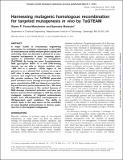| dc.contributor.author | Finney-Manchester, Shawn Pete | |
| dc.contributor.author | Maheshri, Narendra | |
| dc.date.accessioned | 2013-04-24T16:03:28Z | |
| dc.date.available | 2013-04-24T16:03:28Z | |
| dc.date.issued | 2013-03 | |
| dc.date.submitted | 2013-02 | |
| dc.identifier.issn | 0305-1048 | |
| dc.identifier.issn | 1362-4962 | |
| dc.identifier.uri | http://hdl.handle.net/1721.1/78588 | |
| dc.description.abstract | A major hurdle to evolutionary engineering approaches for multigenic phenotypes is the ability to simultaneously modify multiple genes rapidly and selectively. Here, we describe a method for in vivo-targeted mutagenesis in yeast, targeting glycosylases to embedded arrays for mutagenesis (TaGTEAM). By fusing the yeast 3-methyladenine DNA glycosylase MAG1 to a tetR DNA-binding domain, we are able to elevate mutation rates >800 fold in a specific ∼20-kb region of the genome or on a plasmid that contains an array of tetO sites. A wide spectrum of transitions, transversions and single base deletions are observed. We provide evidence that TaGTEAM generated point mutations occur through error-prone homologous recombination (HR) and depend on resectioning and the error-prone polymerase Pol ζ. We show that HR is error-prone in this context because of DNA damage checkpoint activation and base pair lesions and use this knowledge to shift the primary mutagenic outcome of targeted endonuclease breaks from HR-independent rearrangements to HR-dependent point mutations. The ability to switch repair in this way opens up the possibility of using targeted endonucleases in diverse organisms for in vivo-targeted mutagenesis. | en_US |
| dc.description.sponsorship | National Institute of Environmental Health Sciences (Pilot P30-ES002109) | en_US |
| dc.language.iso | en_US | |
| dc.publisher | Oxford University Press | en_US |
| dc.relation.isversionof | http://dx.doi.org/10.1093/nar/gkt150 | en_US |
| dc.rights | Creative Commons Attribution Non-Commercial | en_US |
| dc.rights.uri | http://creativecommons.org/licenses/by-nc/3.0 | en_US |
| dc.source | Oxford University Press | en_US |
| dc.title | Harnessing mutagenic homologous recombination for targeted mutagenesis in vivo by TaGTEAM | en_US |
| dc.type | Article | en_US |
| dc.identifier.citation | Finney-Manchester, S. P., and N. Maheshri. “Harnessing Mutagenic Homologous Recombination for Targeted Mutagenesis in Vivo by TaGTEAM.” Nucleic Acids Research (2013). | en_US |
| dc.contributor.department | Massachusetts Institute of Technology. Department of Chemical Engineering | en_US |
| dc.contributor.department | Massachusetts Institute of Technology. School of Engineering | en_US |
| dc.contributor.mitauthor | Finney-Manchester, Shawn Pete | |
| dc.contributor.mitauthor | Maheshri, Narendra | |
| dc.relation.journal | Nucleic Acids Research | en_US |
| dc.eprint.version | Final published version | en_US |
| dc.type.uri | http://purl.org/eprint/type/JournalArticle | en_US |
| eprint.status | http://purl.org/eprint/status/PeerReviewed | en_US |
| dspace.orderedauthors | Finney-Manchester, S. P.; Maheshri, N. | en |
| mit.license | PUBLISHER_CC | en_US |
| mit.metadata.status | Complete | |
